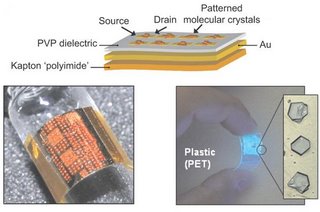15 December 2006
 Fabricating large-scale semiconducting surfaces for the flexible screens of the future is a bothersome business. A simple technique for growing single-crystal organic semiconductors, developed by researchers at Stanford and UCLA, brings new vision to the field.
Fabricating large-scale semiconducting surfaces for the flexible screens of the future is a bothersome business. A simple technique for growing single-crystal organic semiconductors, developed by researchers at Stanford and UCLA, brings new vision to the field.Single-crystal organic transistors are fast, but such devices always had to be made by manual selection and placing of individual crystals. The trick to being able to manufacture -- rather than handcraft -- large arrays of single-crystal transistors was to devise a method for printing transistor patterns on silicon wafers, flexible plastic and other surfaces.
They first put electrodes on these surfaces wherever a transistor is desired. Then they make a stamp with the desired pattern out of a polymer (PDMS).
After coating the stamp with a crystal growth agent called octadecyltriethoxysilane (OTS) and pressing it onto the surface, they then introduce a vapor of the organic crystal material onto the OTS-patterned surfaces. The vapor will condense and grow semiconducting organic single crystals only where the agent lies. With the crystals bridging the electrodes, transistors are formed.
The study is reported in the Dec. 14 issue of the journal Nature.
Update on Dec. 29, 2006: watch a video demo here.
(Image copyright: Nature Publishing Group)
0 Comments:
All Topics



